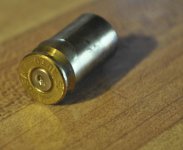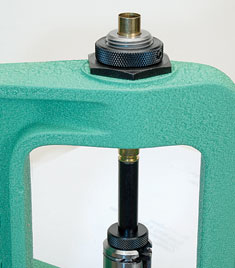Hello all, I'm new to reloading and have a .40 carbine. The chamber of my gun is not fully enclosed so although I didn't check it I assume that it makes a bulge similar to the glocks. Also lots of the brass I got is bulged. On the lee bulge buster they specifically warn you that glocked brass may not be safe even if the bulge is smoothed out, but it seems like everyone does it anyway. Does anyone know of a story of a casing cracking ?
You are using an out of date browser. It may not display this or other websites correctly.
You should upgrade or use an alternative browser.
You should upgrade or use an alternative browser.
Glocked .40 casings
- Thread starter samfried
- Start date
it seems like everyone does it anyway
I do it anyway.
I don't own or load for 40 S&W. But I collect 40 S&W range brass and recondition it for reloading - and that includes Lee Bulge Busting. "Glocked" brass is easy to see, with its discernible bulge. I then look at the primer for confirmation, and sure enough, it has that tell-tale Glock striker mark. I've so thoroughly confirmed this, that I don't even bother looking any more.
I digress. Back to your question:
Although I don't load for 40, I do load for 10mm Auto. I have two Glock 10mm's (20sf, 29sf), and they glock the brass. I bulge bust the brass and reload it with no problems. I figure if it can be done for 10mm, it can be done for 40 S&W.
Haven't been loading 40 S&W but a couple years and have bought once fired brass mostly Winchester. My sizing die was leaving a ring around some cases where the sizing die mouth stopped. Cases appeared to have been fired in a generous chamber and not an unsupported chamber. I bought a Redding GR-X carbide push through sizing die and now my sized cases are perfect. I have found a few cases in my bought once fired brass with a guppy belly and this brass appears to have fired not fully chambered? This guppy belly is what I consider dangerous to reload. You have to inspect all cases to find any with this badly bulged base and carefully. Do not reload any of these badly bulged cases. The push through GR-X die will barely notice this bulge and will size down the bulge. I highly recommend the Redding carbide GR-X die for sizing slightly swelled brass but not for bulged cases. I reload for a Glock 23 and my Beretta carbine and don't have any issues with my fired brass, only bought once fired. Here's a discussion with pics of guppy belly brass that would be dangerous to reload:
http://www.thefirearmsforum.com/threads/guppy-bulge-reload-or-toss.136611/
NOTE: the guppy bulge is only on one side of the case and doesn't go all the way around.
http://www.thefirearmsforum.com/threads/guppy-bulge-reload-or-toss.136611/
NOTE: the guppy bulge is only on one side of the case and doesn't go all the way around.
Jay Locker
Inactive
I just collected about 250 rounds of 40, and I saw one case that was bulged. I save the stuff for my nephew. There was a training session for armed guards, and those boys dumped thousands of rounds. I'm guessing that each man fired probably 3-500.
Is there anything more disturbing than hearing the shooting stop, and then hearing someone shout "YOU HIT THE HOSTAGE!!!!"
Is there anything more disturbing than hearing the shooting stop, and then hearing someone shout "YOU HIT THE HOSTAGE!!!!"
oldmanFCSA
New member
I run ALL of my 40S&W brass thru a special setup using a modified carbide sizing die and a specialized pusher.
The RCBS Carbide sizing die has been modified by removing the decapping rod and boring the top of die out to a diameter slightly larger than 40S&W brass casings. Then I added a piece of curved electrical plastic conduit tubing to top of die to direct sized casings to a box.
The special pusher has a short decapping pin sticking out of a reduced body that fits inside a 40S&W case allowing the pin to push out the primer and the small body to push against the web of the casing and push the case thru the die primer pocket first.
Load case with flash hole over decapping pin, stroke ram upwards, primer pushes out first, then entire case is pushed thru die. It sticks in die which allows for next piece of brass to push out the first, and so on.
This process works so well I'm working on automating the process.
This style of processing pushes the brass bulge back to the original location thus not weakening the case due to thinning as other debulging die systems do. I've used this process now on literally thousands of cases with absolutely no problems or failures. Use of a RCBS Carbide die does reduced the diameter of the case down to 0.422" instead of the 0.424" specification in books. A measurement of different brands of cases shows most have reduced diameters directly from the factory loadings, so the main change is the web area which is exactly where this area of concern starts.
The RCBS Carbide sizing die has been modified by removing the decapping rod and boring the top of die out to a diameter slightly larger than 40S&W brass casings. Then I added a piece of curved electrical plastic conduit tubing to top of die to direct sized casings to a box.
The special pusher has a short decapping pin sticking out of a reduced body that fits inside a 40S&W case allowing the pin to push out the primer and the small body to push against the web of the casing and push the case thru the die primer pocket first.
Load case with flash hole over decapping pin, stroke ram upwards, primer pushes out first, then entire case is pushed thru die. It sticks in die which allows for next piece of brass to push out the first, and so on.
This process works so well I'm working on automating the process.
This style of processing pushes the brass bulge back to the original location thus not weakening the case due to thinning as other debulging die systems do. I've used this process now on literally thousands of cases with absolutely no problems or failures. Use of a RCBS Carbide die does reduced the diameter of the case down to 0.422" instead of the 0.424" specification in books. A measurement of different brands of cases shows most have reduced diameters directly from the factory loadings, so the main change is the web area which is exactly where this area of concern starts.
Jes a couple thoughts. Reloading any round is pretty easy, and good, reliable information is available but when you start assuming, you're gonna find trouble sooner or later. Make sure. At least closely inspect your brass visibly. If you can't see a bulge, measure a few to double check. Remember "if everyone else jumps off a cliff does that mean you should jump too?". There's more good reliable sources of factual info rather than the local range rat, or gun shop guru or even a reloading forum. Try the gun's manufacturer. Try the reloading manuals. Try the maker of your components (brass, bullets, etc.).Hello all, I'm new to reloading and have a .40 carbine. The chamber of my gun is not fully enclosed so although I didn't check it I assume that it makes a bulge similar to the glocks. Also lots of the brass I got is bulged. On the lee bulge buster they specifically warn you that glocked brass may not be safe even if the bulge is smoothed out, but it seems like everyone does it anyway. Does anyone know of a story of a casing cracking ?
Some folks say that bulging and ironing out bulges of your brass weakens it at that point. Some say if the case is indexed to the same position with the weak spot over the missing chamber area, the case can blow out. That's just what I've read and don't have a .40, so take that with a grain of Bullseye...
Not ragging on you, just a bit of info for a new reloader. Personally, I pay no attention to any forum expert, range rat, gun counter clerk, pet loads web site, or gun shop guru when it comes to load data, and I double check any information about altering/modifying my guns...
Go slow, double check everything, and most important have fun...
oldmanFCSA
New member
9X45,
I've used the Redding G-RX die but was not impressed with it as it is intended to push a case thru primer pocket down.
My process removes the primer and re-forms the case on same stroke of press, and more importantly, pushes the displaced brass back into its original location, thus not further weakening the case body.
Think it thru, how is metal of case displaced, and how to push it back to proper location. I firmly believe my processing of 40S&W brass solves the bulge problem for reloading.
I've used the Redding G-RX die but was not impressed with it as it is intended to push a case thru primer pocket down.
My process removes the primer and re-forms the case on same stroke of press, and more importantly, pushes the displaced brass back into its original location, thus not further weakening the case body.
Think it thru, how is metal of case displaced, and how to push it back to proper location. I firmly believe my processing of 40S&W brass solves the bulge problem for reloading.




